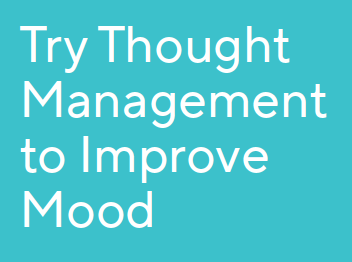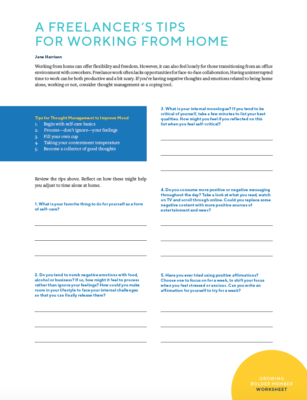By: Jane Harrison
With the world stuck at home, too much alone time can wreak havoc on our mental state. People, places, things — our everyday distractions have been stripped away. Add to that the list of distressing byproducts of the pandemic, it’s no wonder our minds are going from one unpleasant thought to the next. How can we calm ourselves? Enter thought management.

Now is the time to stop giving your inner thoughts permission to run rampant. Similar in meaning to time management, thought management is the process of exercising conscious control of your thoughts. It is accepting the notion that you determine the quality of your thoughts. And you have the power to put an end to the suffering.
Having worked from home as a freelance writer for more than two decades, I’m well aware of how my thinking impacts my overall frame of mind. Here are five things you can do today to employ thought management, experience more inner peace and enjoy life on a deeper level.
Begin with self-care basics
The best way to wake up every day with a positive state of mind? Love yourself enough to live a healthy lifestyle. Start by incorporating these essential self-care basics: Eat nourishing foods, adopt an exercise routine, stay connected to your loved ones, prioritize sleep, meditate; and whenever possible, soak up a little sunshine. You might also consider enlisting a friend to be an accountability partner in your new practice of self-care. This may sound like familiar advice to some, but I find a quick review is always helpful.
Process — don’t ignore — your feelings
Too often, we try to avoid, stuff or ignore our negative feelings. Unfortunately, diverting yourself only means that the feeling will return. Without effective intervention, the distress will continue. Perhaps the most crucial thought management tool is to learn to process feelings correctly. When I first began working from home as a freelancer, I was haunted by unpleasant thoughts and memories. I had practically endless alone time and no awareness of the concept of thought management. I decided to see a therapist to tackle the problem. I’m paraphrasing the therapist’s advice: Think about what it feels like to be full after a big meal. You’re confident that within a short time, your body will process the food, and you will feel comfortable again. Thought management is similar. When a bad thought comes into your mind, acknowledge it with the same confidence. Tell yourself you feel shame, fear or sadness; and then sit with the feeling for a few minutes while your brain processes it. All the while, know that soon enough, it will move through you and leave your mind for good. Name it, feel it and let it move through you — a simple strategy that helped put an end to my torment. Today, I process feelings naturally without thinking about it. I also wake up each day with a peaceful state of mind.
Fill your own cup
Oftentimes, negative thoughts become self-sabotaging and can make us feel like there’s something wrong with us. Filling your own cup works to rebuild confidence and cultivate a calm, positive mindset. Find a comfortable place to sit. Make a mental list of all your good qualities. What are some of your accomplishments? Who have you helped during this difficult time? What problems have you solved at work? Are you strong, clever, witty? A good listener? Keep going. When you’ve collected a complete and thorough inventory of your most beautiful qualities, take a few extra minutes to reflect on them. Once your cup is full, you should be well on your way to feeling less anxious and more at peace with yourself.
Taking your contentment temperature
Learning to limit negative distractions and encourage positive activities begins with taking your contentment temperature: How do I feel? Am I anxious? Relaxed? Satisfied? What could I be doing that would feel better? You can improve the balance in your life by putting limits on scary news, toxic people and violent TV. Focus more time and attention on fulfilling acts like meditation, inspiring programs (think TED Talks), gardening or learning a new instrument or language. A good analogy is food shopping. Imagine filling your cart with only fresh, healthy food and eliminating processed and sugary snacks. When you go through the next week, it’s that much harder to eat junk food because it’s not in the house. How many times have you craved something sweet only to find yourself happy you satisfied your craving with something nutritious?
Become a collector of good thoughts
Positive affirmations are popular for a good reason — they work. They are a potent strategy to release you from negativity and stress. Repeated often, they have the power to slowly change your thinking, overcome negative thoughts and encourage growth. An affirmation is a goal in its already completed state. It’s simple and positive. I AM peaceful. Once you settle on a statement, write it down and place it around the house and in your car as a reminder. To take self-affirmation a step further, create a video in your mind of all the beautiful places you’ve seen or want to see. Include good memories, dreams and goals. I collect good thoughts.
“What a lovely surprise to finally discover how unlonely being alone can be.” — Ellen Burstyn
Because you’ve made it this far in the article, you’re on your way to inner peace. As Eckhart Tolle says, “Awareness is the greatest agent for change.” You now know that you can control your thoughts. That’s big. Take a minute to feel good about where you are right now. Adopt these new tips and strategies as fast or as slow as you need. Take your first step. Stop. Compliment yourself. Then take another step. This is not a race. The time will come when changing your thoughts will happen just as easily as blinking your eyes.
















